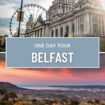
We are reader-supported and may earn a commission on purchases made through links in this article.
A light drizzle fell onto the cobblestoned street as our taxi arrived. Stepping into the black cab felt like diving headfirst into Belfast’s tempestuous past. We were in for a raw and personal tour of the city.
Our Taxi driver, Pat, welcomed us with a rough, smokey voice. “Craic alright?”
A little confused by his phrase, we smiled and nodded our good mornings to him. Cheerful as his projection was, it looked like maybe he was having a bit of a rough morning.
“More about the craic later,” he said, and we remembered that in Ireland, craic referred to fun. “Let’s be on our way.”
Belfast and Its Troubled Past
Nataliya and I were in Belfast, Ireland, for the day, taking a break from our time in Dublin. This was our first visit to Northern Ireland (or North of Ireland as Dubliners prefer to call it).
Unlike the fully independent Republic of Ireland to the south, Northern Ireland remains a part of the United Kingdom, under the protection of the Crown—or under the thumb of it, depending on who you ask.
“The Troubles” have lessened, and things seem calm and peaceful in Belfast today. But the memory of those times—from the late 1960s to the late 1990s—still lives in the memories of many citizens, including the cab drivers who have made it a profession and a passion to share the stories of that time with visitors.
The Remnants of The Troubles
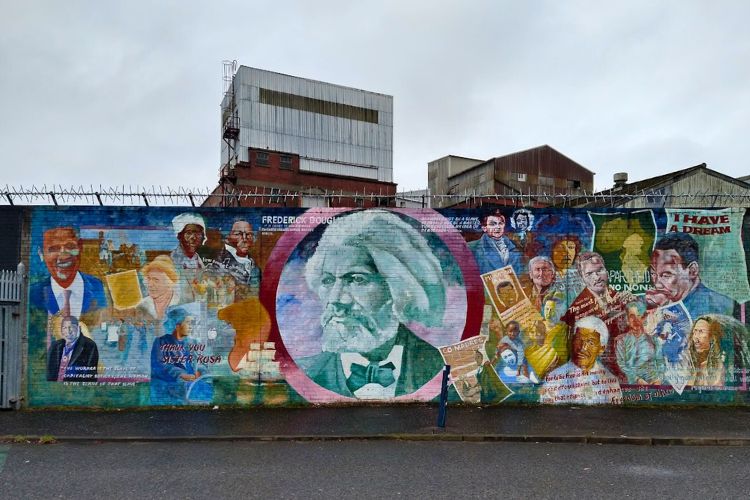
The conflict was between England and Ireland, but closer still, it was between the residents of Belfast, between unionist Catholics who wanted to unite with the Republic of Ireland and loyalist Protestants who were loyal to the crown and wanted to remain part of the United Kingdom.
These political disagreements still exist today, but they’re negotiated in political conversations rather than with bullets and bombs.
Planning a last-minute trip to Ireland?
Top Experiences and Tours in Ireland:
- See the sights with a tour of Dublin: Cliffs of Moher, Kilmacduagh Abbey, Wild Atlantic way and Galway
- See a castle with Blarney Castle Day Tour from Dublin Including Rock of Cashel & Cork City
- Explore more with a Game of Thrones Studio Tour Admission Ticket
Where to stay in Ireland:
- Find accommodation with Booking.com
- Get a rail pass through Rail Europe
- Find Bus, Train, and Flight tickets with one search through Omio
Differently opinioned communities were walled off from one another. The tenement houses were so close together, that neighbors from opposite sides of the wall on the upper floors could see one another, but it took the open gate door of daytime and a good 20-minute drive to get from one side to the other.
Pat asked us where we were from. “Why the hell would you want to come to Belfast?” He laughed. “A little like taking a holiday to a war zone, eh?”
We weren’t sure how to respond. There was a bit of cough to his laugh. “Don’t worry, the troubles aren’t what they used to be. Don’t mind all of the barrier walls or bullet holes. All part of the past. Belfast is a lovely place to visit today.”
Political Activism through Graffiti and Murals
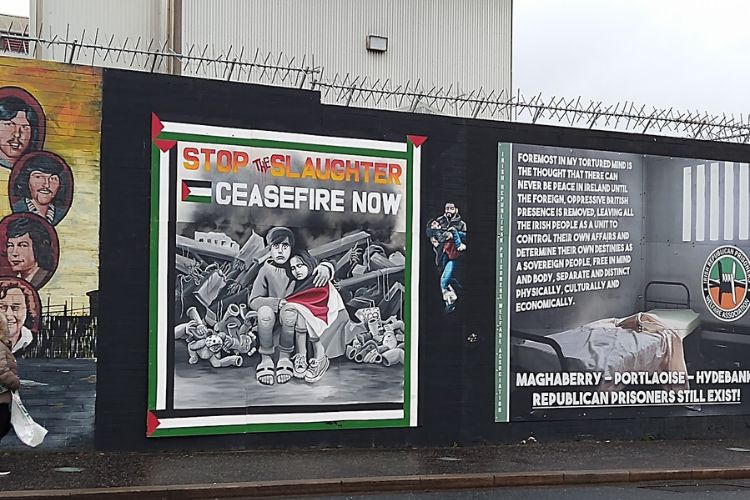
Walls were everywhere, it seemed, and every inch was covered in graffiti. He explained that it began as true graffiti, but it was mostly commissioned graffiti. That is, political and activist groups can apply for a space on the wall and commission an artist to paint their messages.
During several stops along the way, we got out to take a closer look at the murals. Some were old, others fresh; some more permeant, others destined to be painted over with fresher messages.
Along Falls Road, we saw a mural of Bobby Sands, the IRA hunger striker. Other murals showcased global struggles for freedom and human rights, featuring images of Barack Obama, Martin Luther King Jr., Nelson Mandela, and Harriett Tubman.
A Women’s Voices Matter mural promoted gender equality and the need to amplify women’s voices, and a “Solidarity with Palestine” mural expressed support for the Palestinian people.
The Significance of Walls and Gates
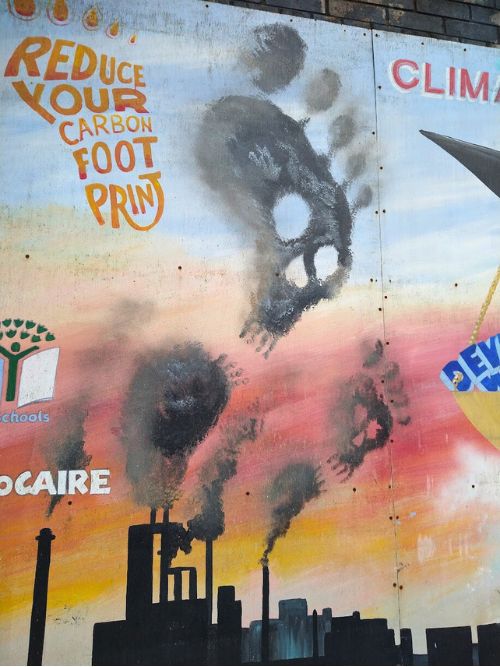
“Walls don’t just divide land,” Pat said, his voice turning somber. “They divide hearts. But sometimes, they also offer time to cool down.”
He explained the ingenious design of the gates, locked nightly, forcing a ten-minute detour through neutral ground. “Gives a hothead a chance to breathe, to think twice before crossing that line. Especially if they have a gun or an explosive in their passenger seat.”
We crossed through a gate to the other side, where the wall had messages loyal to the Crown and establishment. One mural proclaimed that the Guinness family was a family of loyalists (which our cabbie claimed was an exaggeration—although Sir Arther Guinness was knighted). Another featured an image of Queen Elizabeth II.
Pat likened the British presence in Ireland to a hypothetical Russian invasion of Baltimore. “Oh, it’s peaceful now in this imagined America, and you’re still American. But now the Russians rule over you.
You’d still be American, wouldn’t you?” We nodded. “You’d want your kids in American schools, fight for your American flag. It’s the same here. One side wants to be Irish, plants themselves deep in Irish soil. The other,” he gestured toward a towering mural depicting the Queen, “they’re British, roots and all.”
The Peace Wall
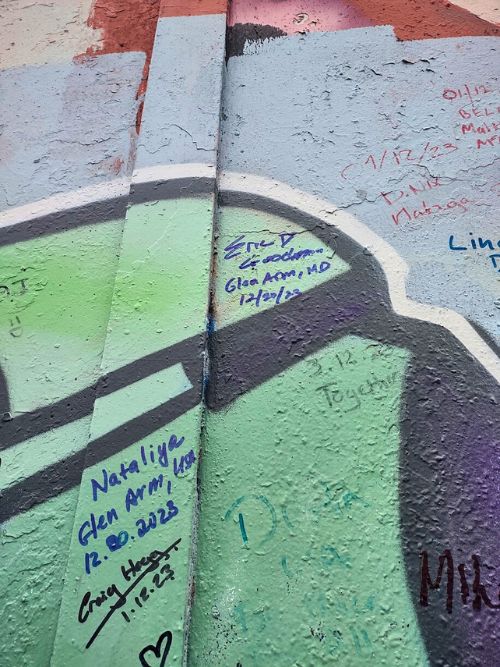
We hopped back in the cab and came to the Peace Wall, which seemed to be covered in more traditional graffiti—artists tagging their names and messages all along it. “This wasn’t built as a peace wall when it went up,” Pat said. “But now, it’s covered with messages from visitors calling for peace and reconciliation.
U2 was here and signed the wall. Your Obama was here. The Clintons were here to sign the wall.” He pulled out two markers. “And now, you can do the same.”
Nataliya and I each took a marker and signed our names. It felt less like vandalism and more like joining voices in a collective call for peace.
Celebrity Spotting and Lost in Translation Humor
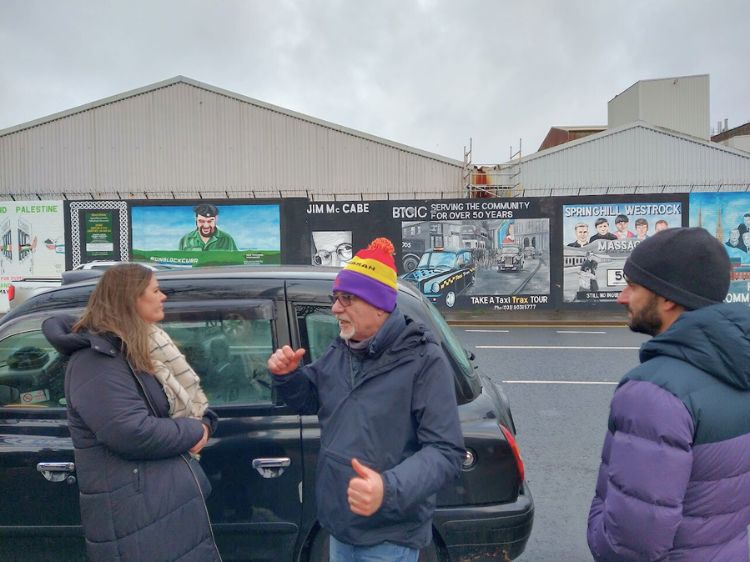
As we continued our drive around Belfast, Pat grew more playful. “See those apartment buildings there?” He pointed. “Rihanna shot a music video there. I ended up meeting her. Nice Irishwoman.” He looked at us. “Bet you didn’t know she was part Irish.”
In fact, we did, but only because we’d learned that at a museum in Dublin. Pat continued to name-drop. “I got drunk with Brad Pitt once in one of the local pubs. When celebrities are here, they always want to hit one of the pubs, and we drivers usually know where to go if we want to have a pint with them.”
But the funniest story he relayed was about an elderly couple who once sat in the back of his cab. “They seemed half dead, barely alive. But as I was about to end the tour, the old Brit asks me to take him to an Irish pub. I say, sure, I know one where the craik is good. He looked a little scared at that, and asked me to just take him to his hotel.”
We laughed, wondering about the origin of the use of craik to mean fun in Ireland.
“I’m in the hotel lobby, having a bit of water before my next passenger arrives, and I hear him rat me out to the front desk. He says the driver tried to take me to a pub with crack. Well, the clerk says back to him, you should have gone, I’m sure the craik would have been great!” We laughed out loud with him.
The Titanic Museum
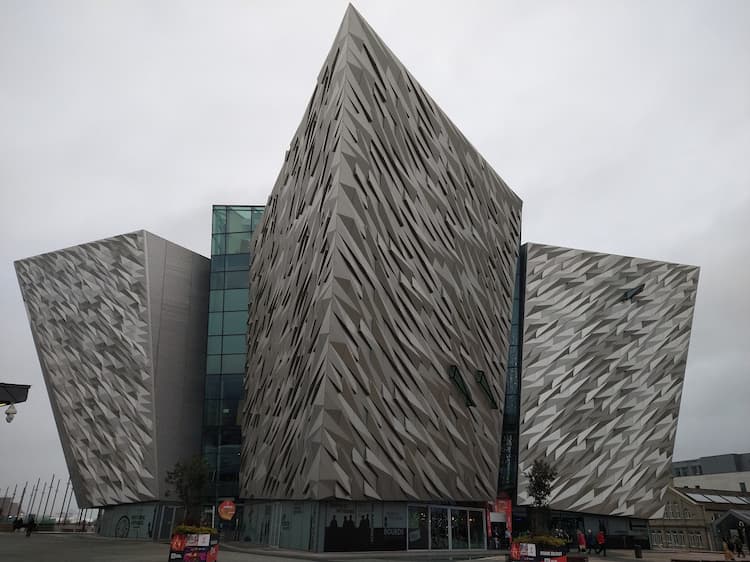
The tour ended at the Titanic Museum. As we stepped out of the black cab, the rain had stopped, and a sliver of sun peeked through the clouds. It felt symbolic, a ray of optimism illuminating the city’s complex narrative.
We walked the length of the ill-fated ship on the back dock and imagined the dreams and anxieties of its passengers, a microcosm of the city itself: ambition, struggle, and ultimately, an unyielding hope.
The Titanic Museum was a poignant symbol of both Belfast’s tragic past and its resilient spirit. This is where the Titanic was built, and the modern museum showcases the Titanic’s creation and fate.
Hope for a United Ireland
Belfast, we learned, wasn’t just a place marked by division; it was a vibrant tapestry woven with stories of resilience, humor, and an unwavering belief in a shared future, one where walls might someday crumble and hearts find common ground.
In our conversations with locals, both in Belfast and Dublin, the consensus seemed to be that North and South would unite one day in the near future; the only thing in debate now is when. Loyalists still long to remain under the umbrella of the United Kingdom. But a growing number of people on both sides of the wall—on both sides of the border—want a united Ireland.
In the pubs and streets and even in the cabs, most people we talked to who spoke about the issue seemed to think that Northern Ireland would unite with the Republic of Ireland in the next 5, 10, 20 years and free itself of Britain’s rule. This seemed like a giant step. The United Kingdom has agreed that if a referendum is passed, it will not stand in the way.
Dunluce Castle on the Antrim Coast
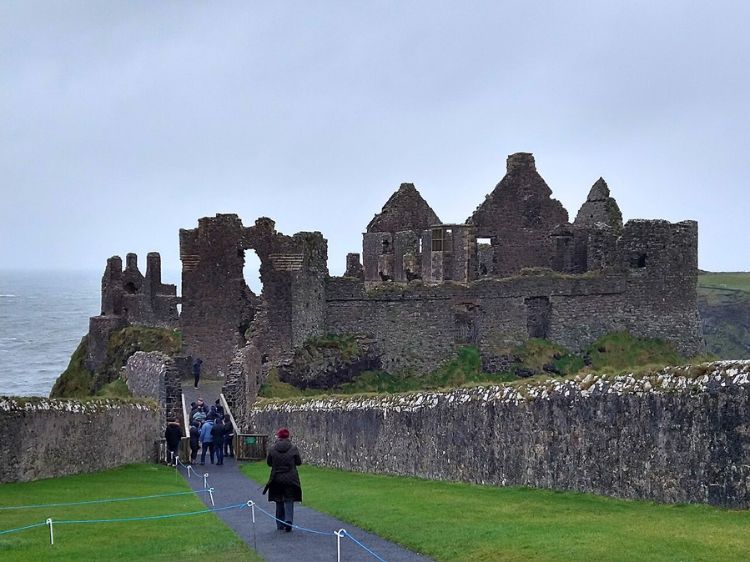
Leaving Belfast’s bustle behind, the Antrim Coast Road unfurled like a verdant ribbon. Rolling hills painted with emerald gave way to the Irish Sea’s cerulean expanse. Sunlight peeked through the clouds between short rainfalls.
The sun danced on the water, throwing diamonds across the crashing waves and highlighting the dramatic cliffs that rose sharply from the shoreline.
Before we knew it, a majestic apparition materialized: Dunluce Castle, perched precariously on a craggy outcrop. Now an elaborate web of stone walls and ruins, the castle appeared to be a prime location overlooking the Irish Sea from high.
Built in the 1200s, Dunluce was once a stronghold of the McQuillan Clan, later seized by the MacDonnells. Under the Earls of Antrim, it became host to a small town. But the Battle of the Boyne signaled the decline of the Antrims and the castle was eventually abandoned.
There were areas we walked where you could look down at the bottom of the wall and see holes in the ground dropping into the sea far below. Other views, from above the walls, offered grand views of the sea.
Resuming our journey, the road snaked along the coastline, revealing hidden coves and charming villages with colorful houses huddled against the wind.
Giant’s Causeway
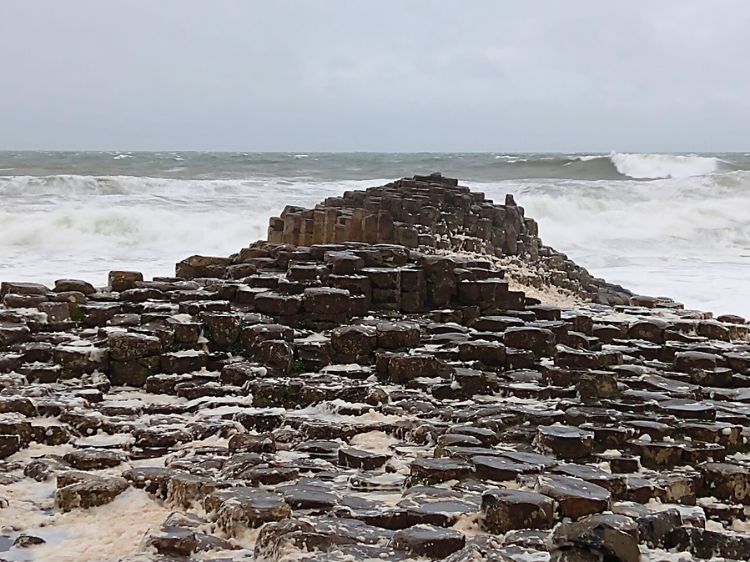
Our final destination in Northern Ireland was Giant’s Causeway. Nataliya and I bundled up against the whipping wind, the Irish Sea’s North Channel roaring its defiance in the distance. We descended the hillside road along the coast toward the legendary Giant’s Causeway, a mythical landscape carved by ancient volcanic fury.
The ocean line was sudsy, with salty suds not only along the shore but airborne in the wind. Descending the path, the wind tugged at us, carrying salty suds from the churning sea. One landed on my face, the salty taste overwhelming.
Before long, the columns came into view—thousands of them, hexagonal giants sculpted from basalt, their tops forming a smooth, uneven path leading into the sea. It felt like stepping onto the set of a fantasy film, where nature defied logic with its raw, geometric beauty.
“This reminds me of that old Atari video game,” I said. “Q-Bert.”
Each pillar had its own unique character, some straight and tall, others leaning precariously. The wind sighed through the gaps, creating a haunting melody that resonated with the ocean’s roar.
The Story Behind the Name
We walked among the giants, taking in the intricate details etched by time and lava. Sunlight glinted off the wet surfaces, turning them into prisms reflecting the ever-changing hues of the sky. It was a humbling experience, standing beside these ancient sentinels, feeling the immensity of time and the enduring power of nature.
A ranger told us of another explanation. “Some say that these pillars are what remains of a bridge that an Irishman built to reach Scotland, where a giant had challenged him to battle.
Once the bridge was built and the Irishman crossed, he got one look at the fierce Scottish giant and ran back. His wife hid him in bed and told him she would take care of it. When the giant showed up, she said that he had gone off to train for their battle. The giant saw the Irishman in bed, and asked about him. She explained that was his infant son.”
The wind whipped the ranger’s hair as he spoke. “Well, the giant high-tailed it back to Scotland and destroyed the bridge—because if that’s what the baby looked like, whiskers and all, he certainly didn’t want to fight the Irishman!”
What we witnessed was the remaining pillars of the bridge that had once crossed all the way to Scotland. “Unless you want to go with the scientific explanation,” the ranger said with a smirk.
Farewell to Northern Ireland
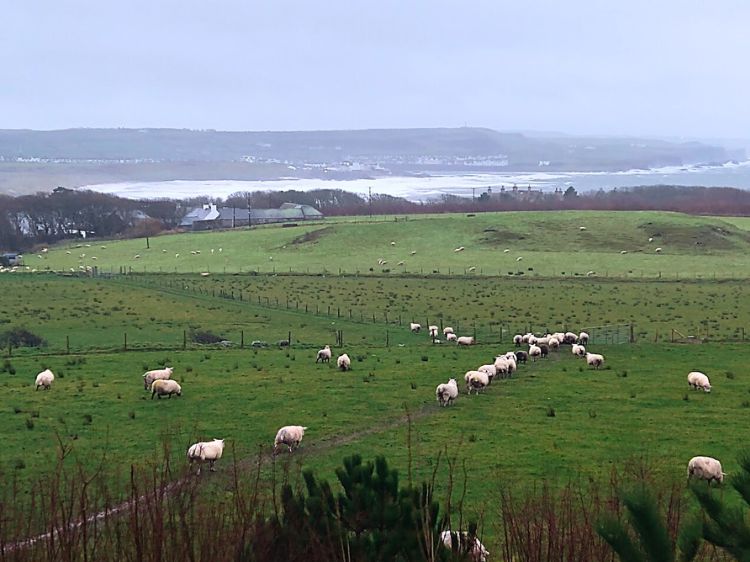
After spending some time enjoying the Giant’s Causeway, climbing on the pillars, careful not to slip on the wet, sudsy rock, we made our way back up the windy hill where a small inn offered hot food and drink. Nataliya had the seafood chowder and I enjoyed a fresh fish and chips. We washed it down with a hot whiskey drink made with water and lemon. It was the perfect antidote to the windy chill outside.
Beyond the parking lot, emerald hills rolled down to the crashing waves, dotted with fluffy sheep-like cotton balls against the green. Perhaps it was too windy for them, perhaps it was time to go inside, but they all seemed to decide at once it was time to migrate. That was our signal to depart.
The sun was setting and now it was twilight. We returned to the road, headed back to the Republic of Ireland after a full day in Northern Ireland—or North of Ireland, as our friends in Dublin called it.
If You Go:
For most travelers from the United States, the point of entry into the Emerald Isle is through Dublin. That was the case for us. There are countless flights from U.S. cities to Dublin; we opted for an affordable Icelandic flight from Baltimore-Washington airport to Dublin with a layover in Reykjavik, Iceland.
It is easy to travel from the Republic of Ireland to Northern Ireland (part of the United Kingdom). You can rent a car and pass freely over the border. Given our time, however, we opted for a convenient day trip by a small-group coach that took care of all the travel, needs, and arrangements. Many online companies provide such packages at a low price, including Viator.
Back in Dublin, there are many lodging options, and most tourists opt to be south of the Liffey River. However, there are safe, clean, and affordable options in Georgian townhouses on the north side of the river as well. Gardiner Lodge provided a full Irish breakfast each morning and a very helpful, 24-hour front desk clerk.
Read More:
Author Bio: Eric D. Goodman is author of seven books. His most recent is Faraway Tables, a collection of poems focused on travel and a longing for other places. His novels include Wrecks and Ruins (set in Baltimore and Lithuania) and The Color of Jadeite (a thriller set in China). Hundreds of his stories, poems, articles, and travel stories have been published. Learn more about Eric and his writing at www.EricDGoodman.com.

